Abstract
Background: The leading global risk factor for cardiovascular-disease-related morbidity and mortality is hypertension. In the past decade, attention has been paid to increase females’ representation. The aim of this study is to investigate whether the representation of females and presentation of sex-stratified data in studies investigating the effect of antihypertensive drugs has increased over the past decades. Methods: After systematically searching PubMed and Embase for studies evaluating the effect of the five major antihypertensive medication groups until May 2020, a scoping review was performed. The primary outcome was the proportion of included females. The secondary outcome was whether sex stratification was performed. Results: The search resulted in 73,867 articles. After the selection progress, 2046 studies were included for further analysis. These studies included 1,348,172 adults with a mean percentage of females participating of 38.1%. Female participation in antihypertensive studies showed an increase each year by 0.2% (95% CI 0.36–0.52), p < 0.01). Only 75 (3.7%) studies performed sex stratification, and this was the highest between 2011 and 2020 (7.2%). Conclusion: Female participation showed a slight increase in the past decade but is still underrepresented compared to males. As data are infrequently sex-stratified, more attention is needed to possible sex-related differences in treatment effects to different antihypertensive compounds.
1. Introduction
Cardiovascular diseases (CVDs) are the leading cause of death in females worldwide and responsible for approximately 35.0% of all female deaths in 2019 [1,2,3,4]. Hypertension is the leading risk factor for CVD morbidity and mortality, and is the most substantial and neglected health burden in females [5]. Timely reduction of blood pressure prevents the development of CVD later in life [6]. Historically, females are underrepresented in, or sometimes even excluded from, cardiovascular clinical trials [7,8]. In CVD management, findings from clinical trial data were extrapolated to be equally effective in females and males. Therefore, women are treated equally (the same); however, they are not treated based on equity (i.e., on their health needs). Lack of attention to possible sex-related system-biological differences in (side) effects of pharmacological therapy may have remained undetected and reduced the ability to identify sex-specific differences in important outcomes. If present, this would underscore the need for the development of sex-specific strategies in guideline recommendations for the prevention and management of hypertension and CVD.
The past years, a large number of campaigns led to increased awareness on the impact of CVD in females [9,10,11,12,13,14,15,16]. In 2006, the National Institutes of Health (NIH) decided that drugs are obligated to be tested separately on females but did not require reinvestigation of previously developed drugs. Nonetheless, almost a decade later, important and impactful studies that affected the recommendations in influential guidelines, still not only had sufficient power, nor sex-stratified the findings regarding the female perspective [17,18].
Therefore, we questioned to what extent females were represented for each category of antihypertensive medication and whether the number of included females and sex-stratified data has increased in the past decade compared to the previous decades. We studied the changes in representation of females and sex-stratified data in clinical human studies investigating the five major antihypertensive drug groups.
2. Materials and Methods
2.1. Scoping Review
This scoping review was conducted according to the Preferred Reporting Items for Systematic Reviews and Meta-analyses (PRISMA) guideline [19]. An extensive systematic literature search was conducted on articles evaluating the effects of antihypertensive medication on cardiovascular and hemodynamic variables. Independent duos of ten investigators (Z.M.-A., M.A.M.V., S.A.J.S.L., E.W.P.V., N.W., D.A.A.M., E.M.v.L., C.J.R.D., J.W. and M.F.A.) systematically searched PubMed (NCBI) and Embase (Ovid) databases from inception until May 2020. They reviewed original research articles investigating antihypertensive medication studies over the years (for keywords used in the literature search, see Table 1).

Table 1.
Literature search strategy for PubMed (NCBI) and Embase (Ovid) databases.
The search, inclusion, and exclusion criteria were initially developed for a series of systematic reviews and meta-analyses to assess the effect of the five major groups of antihypertensive drugs on cardiovascular outcomes in females specifically, as compared to males. The current scoping review preludes these meta-analyses and primarily investigates the change over time in the proportion of included females in the studies. Secondary, it investigates to what extent sex stratification was performed.
2.2. Selection of Studies
The identified articles were assessed for eligibility in two phases (Figure 1). First, individual studies were screened based on the title and abstract by independent duos of ten investigators. A predefined study-extraction sheet was used. Second, articles were screened based on full-text suitability based on inclusion and exclusion criteria also by independent duos of the same ten investigators (title–abstract pairs: M.F.A.–E.W.P.V., C.J.R.D.–S.A.J.S.L., E.M.v.L.–D.A.M.M., Z.M.-A.–J.W., M.A.M.V.–N.W.; full-text pairs: C.J.R.D.–N.W., E.M.v.L.–M.A.M.V., D.A.M.M.–S.A.J.S.L., E.W.P.V.–J.W.). Discrepancies for the first and second selection were resolved by mutual agreement of two investigators. When no conclusion could be made, a third investigator was involved to make the decision.
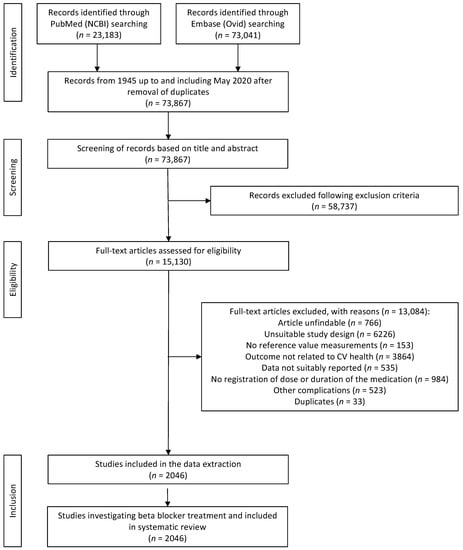
Figure 1.
Flowchart summarizing the process of study selection.
If studies: (1) investigated one class of the five main groups of antihypertensives (beta-blockers (BB), angiotensin-converting enzyme inhibitors (ACEI), angiotensin receptor blockers (ARB), calcium channel blockers (CCB), and diuretics (DIU, all different types could be included), (2) human studies, (3) adults ≥ 18 years of age, and (4) articles written in English or Dutch, then they were included.
Only primary studies were used, so studies with re-usage of a cohort for secondary analysis were excluded. Articles were also excluded if: (1) only the abstract was available and the full report was not obtainable, (2) unsuitable study design (systematic reviews and meta-analyses, literature reviews, case reports, animal studies, and in vitro studies), (3) no reference group included (control, placebo, or other antihypertensive medication group), (4) outcome not related to cardiovascular health, (5) no information regarding specific dose and duration.
2.3. Data Extraction
A predefined data-extraction sheet, including characteristics and outcomes of interest, was used. Study characteristics were extracted, including sample size, sex-stratified outcomes (yes/no), total number of males and total number of females, number of different medication types, names and groups of the different medication types, type of study, and duration of follow-up in days. Anthropometric measures and effect measures, with standard deviation (SD), standard error (SE), or 95% confidence interval (CI), were collected from the eligible studies in predesigned data collection forms. The potential effect of antihypertensives was beyond the scope of this review. Extractions were performed independently by two investigators and then compared to each other to ensure quality and reliability (data extraction pairs: Z.M.–E.V., C.D.–S.L., E.v.L.–D.M., M.V.–N.W.). Discrepancies were resolved by dialogue or discussion with a third independent investigator. Google sheets were used to streamline the data extraction process.
2.4. Statistical Analysis
Statistical analyses were performed using SPSS Statistics version 27·0 (IBM Corp., Armonk, NY, USA). Baseline characteristics and normally distributed variables were reported as mean ± SD. Categorical variables were expressed by number (percentage). Linear regression analyses with beta coefficient (β) and 95% CI were performed to explore the associations between the percentage of females included in the studies. The R-squared provided the amount of variability in the outcome that was accounted for by the predictor variable. We considered a p-value below 0.05 to be statistically significant. Statistical analyses were performed by four investigators (M.V., Z.M., N.W., E.V.).
3. Results
3.1. Study Selection
The search strategy resulted in 73,867 potential articles. Based on title and abstract, 58,737 records were excluded resulting in a total of 15,130 studies eligible for full-text screening. Based on the full text, 13,051 were additionally excluded articles due to the following reasons: article unfindable (n = 766), unsuitable study design (n = 6226), no reference value measurement (n = 153), outcome not related to CV health (n = 3864), data not suitably reported (n = 535), no registration of dose or duration of the medication (n = 984), and the presence of other rare non-hemodynamic comorbidities that may hamper generalization of the effect of drug therapy (i.e., concomitant use of biologicals, specific genetic translocation, chemotherapy, and kidney transplantation) (n = 523). Eventually, after excluding all unsuitable articles, 2046 articles were eligible for data extraction (Figure 1).
3.2. Study Characteristics
Out of the 2046 studies, 1198 (58.6%) studies were randomized controlled trials (RCTs), 773 (37.8%) prospective cohort studies, 43 (2.1%) retrospective cohort studies, 22 (1.1%) case–control studies, and four were cross-sectional studies (0.2%). (Table 2). The remaining six (0.3%) studies had another study design, including multicenter open-label studies (n = 2), open-label trials (n = 2), open non-randomized preliminary study (n = 1), and a pilot study (n = 1) (Table 2, Table S1).

Table 2.
Overall characteristics of the included antihypertensive studies (n = 2046) in the scoping review.
3.3. Prevalence of Included Females and Sex-Stratified Data
The total number of participants in all studies was 1,348,172 adults, of which 38.1% were females, 60.3% males, and 1.6% did not mention sex as seen in Table 3. Sex distinction was not mentioned in 126 (6.2%) studies. Sex-stratified outcome data was not shown in 1706 (83.4%) studies. Female-only cohorts were used in eight (0.4%) studies and male-only cohorts in 131 (6.2%) studies. Sex stratification was performed in 75 (3.7%) studies.

Table 3.
Characteristics of the included antihypertensive studies in the scoping review divided for each decade.
Figure 2 shows the cumulative sum of included females and males over the years from 1964 to 2020. Linear regression analysis revealed that the percentage of females participating in antihypertensive studies increased by 0.2% (95% CI 0.36–0.52%) per year (Table 3). The yearly increase was highest between 2001 and 2010 being 0·5% (95% CI 0.08–0.95) (Table 3). Despite the increase in included females and sex-stratified data, between 2011 and 2020, 38.7% of included participants were female and 7.2% showed sex-stratified data.

Figure 2.
Cumulative sum of the number of females and males (n) participating in included studies over the years from 1964 to 2020.
3.4. Prevalence of Females and Sex-Stratified Data Selective Antihypertensive Medication
Our final analysis is based on 2046 unique antihypertensive papers ranging from 1964 to 2020 studying the effect of 2341 (100.0%) different antihypertensive medicament cohorts (Table 3). Of all studies, 252 (10.8%) studies reported data on DIU, 652 (27.9%) on BB, 442 (18.9%) on CCB, 671 (28.7%) on ACEI, and 324 (13.8%) on ARB.
3.5. Diuretics
In total, 252 studies reported data on DIU between 1964 and 2019. The number of females and males separately was not mentioned in 13 (5.2%) studies. Sex-stratified outcomes were not shown in two hundred and fourteen (84.9%) studies, female-only cohorts were reported in two (0.8%) studies, and male-only cohorts in thirteen (5.2%) studies. Sex stratification in primary study analysis was performed in ten (4.0%) studies. The total number of participants in all studies was 389,873 adults, of which 44.2% were female and 55.5% male. Figure 3 shows the cumulative sum of included females and males over the years from 1964 to 2019 as seen in Table 4. Between 2011 and 2020, 6177 (25.3%) of the included participants were females, and five (7.5%) studies reported sex-stratified analyses.
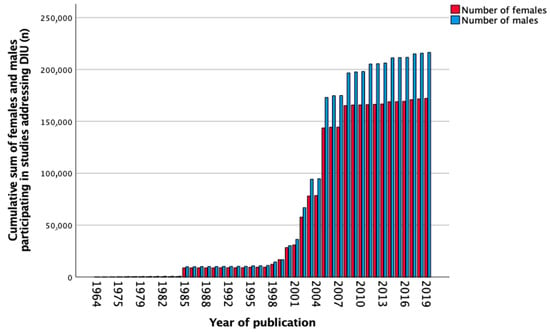
Figure 3.
Cumulative sum of the number of females and males (n) participating in studies addressing diuretics (DIU) over the years.

Table 4.
Characteristics of the included diuretics (DIU) studies in the scoping review.
3.6. Beta-Blockers
In total, 652 studies reported data on BB between 1968 and 2020. The number of females and males separately was not mentioned in 46 (7.1%) studies. Sex-stratified data was not shown in five hundred and thirty-three (81.7%) studies, female-only cohorts were reported in three (0.5%) studies and male-only cohorts in fifty-one (7.8%) studies. Sex stratification was performed in 19 (2.9%) studies. The total number of participants in all the studies was 340,718, of which 36.6% were females, 57.8% males, and 5.6% had undefined sex. Figure 4 shows the cumulative sum of included females and males over the years from 1968 to 2020. The number of females included in the studies increased slightly over the years as seen in Table 5. Between 2011 and 2020, less than half, 16,061 (36.7%) of included participants were females, and five (5.2%) studies reported sex-stratified data.
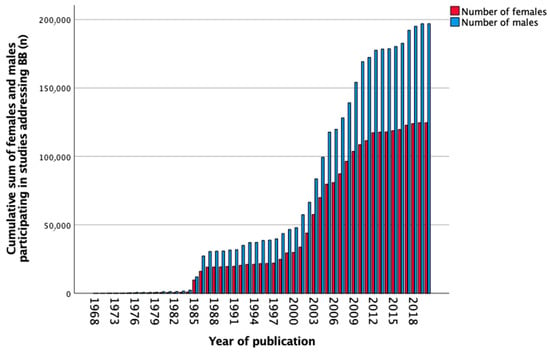
Figure 4.
Cumulative sum of the number of females and males (n) participating in studies addressing beta-blockers (BB) over the years.

Table 5.
Characteristics of the included beta-blockers (BB) studies in the scoping review.
3.7. Calcium Channel Blockers
In total, 442 studies reported data on CCB between 1977 and 2020. The number of females and males separately was not mentioned in 28 (6.3%) studies. Sex-stratified data was not shown in three hundred and sixty-eight (83.3%) studies, female-only cohorts were reported in two (0.5%) studies, and male-only cohorts in thirty (6.8%) studies. Sex stratification was performed in 14 (3.2%) studies. The total number of participants in all studies was 464,084, of which 41.9% were females, 57.7% males, and 0.4% were undefined. Figure 5 shows the cumulative sum of included females and males over the years from 1977 to 2020. The number of females included in the studies increased slightly over the years as seen in Table 6. Between 2011 and 2020, almost half, 11,234 (42.8%) of included participants were females, and four (10.3%) studies reported sex-stratified data.
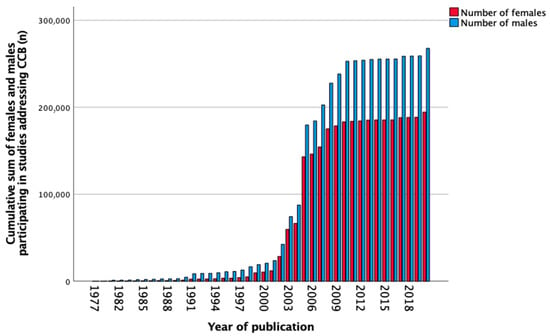
Figure 5.
Cumulative sum of the number of females and males (n) participating in studies addressing calcium channel blockers (CCB) over the years.

Table 6.
Characteristics of the included calcium channel blockers (CCB) studies in the scoping review.
3.8. Angiotensin-Converting Enzyme Inhibitors
In total, 671 studies reported data on ACEI between 1979 and 2019. The number of females and males separately was not mentioned in 31 (4.6%) studies. Sex-stratified data was not shown in 564 (84.1%) studies, female-only cohorts were reported in 0 (0.0%) studies, and male-only cohorts in 31 (4.6%) studies. Sex stratification was performed in 28 (4.2%) studies. The total number of participants in all studies was 546,164, of which 36.9% were females, 62.6% males, and 0.5% were undefined. Figure 6 shows the cumulative sum of included females and males over the years from 1979 to 2019. The number of females included in the studies increased slightly over the years as seen in Table 7. Between 2011 and 2020, still only 14,577 (32.3%) of included participants were females, and seven (20.6%) studies reported sex-stratified data.
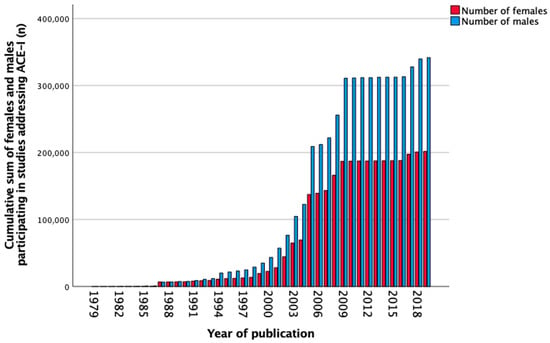
Figure 6.
Cumulative sum of the number of females and males (n) participating in studies addressing angiotensin-converting enzyme inhibitors (ACEI) over the years.

Table 7.
Characteristics of the included angiotensin-converting enzyme inhibitors (ACEI) studies in the scoping review.
3.9. Angiotensin Receptor Blockers
In total, 324 studies reported data on ARB between 1984 to 2020. The number of females and males separately was not mentioned in eight (2.5%) studies. Sex-stratified data was not shown in 295 (91.0%) studies, female-only cohorts were reported in zero (0.0%) studies, and male-only cohorts in seven (2.2%) studies. Sex stratification was performed in 14 (4.3%) studies. The total number of participants in all studies was 379,302, of which 42.2% were females, 55.3% males, and 2.5% were undefined. Figure 7 shows the cumulative sum of included females and males over the years from 1984 to 2020. The number of females included in the studies increased slightly over the years as seen in Table 8. Between 2011 and 2020, almost half, 35,231 (46.2%) of included participants were females, and four (4.8%) studies reported sex-stratified data.
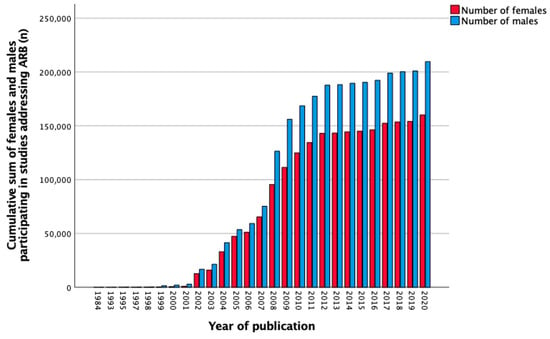
Figure 7.
Cumulative sum of the number of females and males (n) participating in studies addressing angiotensin receptor blockers (ARB) over the years.

Table 8.
Characteristics of the included angiotensin receptor blockers (ARB) studies in the scoping review.
4. Discussions
In the current scoping review, 2046 unique antihypertensive studies comprising 1,395,264 individuals were analyzed over a period between 1964 and 2020. We observed that females are still substantially underrepresented in clinical trials. Despite a yearly increase of 0.2% in included females, in the last decade, one third of the included participants were female. Regarding subtypes of antihypertensive medications, studies on BB least included females and studies on DIU included the highest number of females. Sex stratification in primary study analysis was performed in 3.7% of all included studies over the years, with a percentage of 7.2% in the last decade.
Hypertension is the leading risk factor for stroke, arrhythmia, coronary heart disease, acute coronary syndrome, and heart failure. In line with previous findings, we observed that studies on antihypertensive treatment using the five major antihypertensive drug groups to lower the risk on these CVD outcomes, included less females than males [20,21,22]. As we observed a gradual increase in included women and the sex-stratified display of studied findings, the current awareness of possible differences in effectiveness of antihypertensive compounds is likely to result in a balanced female-to-male inclusion ratio or sex-stratified reports; however, given the slow speed of change, attention is still needed.
Melloni et al. [23] studied 156 RCT’s cited by the 2007 females’ prevention guidelines to determine female representation over time. Considering only trials that enrolled both sexes, female enrolment was 18.0% in 1970, and increased to 34.0% in 2006. They also found that female representation was higher in international versus United-States-only trials (32.7% versus 26.7%) and in primary versus secondary prevention trials (42.6% versus 26.6%). Representation of females was highest among trials in hypertension (44.0%), diabetes (40.0%), and stroke (38.0%), and lowest for heart failure (29.0%), coronary artery disease (25.0%), and hyperlipidemia (28.0%).23 This underrepresentation of females in RCTs and the lack of reporting sex-specific results may imply that the guidelines for CVD prevention in females cannot be reliably based on these studies. In this line of reasoning, cardiovascular risk stratification in this population will need to be established such that risk stratifications are not extrapolated from largely male-retrieved evidence.
Sex-differences in response to antihypertensive treatment may originate from differences in pharmacodynamics, pharmacokinetics, pharmacogenomics, and differences in distribution space. In addition, concurrent disease, originating from different underlying sex-sensitive pathology, may also affect altered responsiveness. These differences may underlie altered responses, side effects, and prognosis between females and males to comparable dosages of antihypertensives [24,25,26,27]. Females report more drug-related side effects from antihypertensive therapy than males [28]. Bots et al. demonstrated that females report more adverse drug reactions and different types of adverse drug reactions compared with men when using ACEI [29]. The sex-specific mechanisms contributing to the multifactorial pathogenesis and varying consequences of hypertension in females are only partly explained in most studies. In addition to the mentioned handling and distribution differences, differences in blood pressure set points and consequently blood pressure targets may also relate to the effectiveness, safety, and gained health [30].
Ljungman et al. described sex differences in antihypertensive treatments and investigated if this could be due to comorbidities [31]. They performed a cohort study within the Swedish Primary Care Cardiovascular Database (40,825 individuals). They found that females were more often treated with diuretics and men with ACEI. Comorbidities could not entirely explain sex differences in antihypertensive treatment using regression models. Men were prescribed ACEI/ARBs and interrupted treatment more often than females. Leading to the conclusion that females and males were treated differently using antihypertensive medications in blood pressure control and they cannot fully explain this by the difference in comorbidities. Walletin et al. investigated the antihypertensive drug treatment in Sweden using the Stockholm Regional Healthcare Data Warehouse (292,428 individuals) [32]. Females more often used DIU, ARB, and BB, while males used more ACEI and CCB. A total of 66% of the females with diabetes and 72% with heart failure used ACEI/ARB versus 76% and 79% in men, respectively. This shows that comorbidities are taken into consideration for antihypertensive medication treatments. However, sex differences in antihypertensive drug treatments prevail.
The lower participation rate of females in studies on antihypertensive drugs raises the question why females are underrepresented. Historically, as a result of excluding women of childbearing age from clinical trials for various reasons, knowledge about diseases originated mainly from research on male animals, cells, and humans [33]. Despite the fact that multiple policies in Canada, the USA, and Europe were implemented to stimulate researchers to take sex and gender into account, it is still viewed as a specialized field of interest rather than a central condition in medical research [34]. In addition, the enrolment process in a study is multifactorial involving several investigators and patient-based and community-based factors. First, the investigator has to incorporate the requirement of balanced participation of both sexes in study designs, unless there is a special need for a study with one sex only. Second, females must actively be made aware of the opportunity to participate via consumer channels. Attention may be needed to the way information is provided as females tend to make decisions differently compared to males, which could lead to different enrolment rates by sex. Generally, females take more time to make a decision, and they require more sources of background information with substantiated pros and cons [35]. Females’ participation may be enhanced with sex-specific clinical trial education materials [22]. From a patient’s perspective, the willingness to participate may also vary between sexes. Ding et al. conducted a randomized study about patient willingness to participate in cardiovascular prevention trials and concluded that males had 15.0% greater willingness to participate compared to females [36]. Among the reasons for this difference was that females generally perceived a greater risk of harm from trial participation. Females had also been shown to take fewer risks than males under stress conditions, and important health-based decisions can be considered a source of stress [37]. RCTs present an added element of risk and uncertainty, and females have been shown to be more reluctant than males to consider participation [38]. From a community perspective, first, lack of support to participate, because of logistic problems such as transportation and childcare, may obstruct the decision to participate. Second, in communities with low literacy, females might have less possibilities to understand information brochures to be comfortable with the clinical trial process, with the process of informed consent, and with the overall clinical trial experience.
4.1. Clinical Implications and Recommendations for Future Research
A useful first step is to communicate better the vast knowledge on sex differences in hypertension management. To ensure meaningfully obtained sex-specific results, novel trial design solutions may be needed. Potential barriers need to be overcome to increase female trial participation, including enhancing the understanding of trial process and logistics, but also enhancing limited clinical trial information from physicians, and misperceptions around the risks and benefits of participation. Furthermore, study protocols should facilitate comparable representation of both sexes by adequate sex-specific powering of trial participants to ensure a large enough group of each sex and by presenting data in a sex-stratified assessment.
Although these designs could be more costly, trial costs can be reduced by specifying the power to detect the clinically relevant interaction effect between sex and treatment, recruiting a prespecified number of females and males, and ceasing enrolment of the particular sex when the sample size target is reached. For already published studies, investigators might consider performing post hoc sex-specific analyses, while considering potential power insufficiencies in the interpretation of the results [39]. Generating an open access database with data from completed clinical trials may be helpful to optimize power allowing individual patient data analysis.
4.2. Strengths and Limitations
This scoping review includes a substantial number of studies in a systematic way aiming to include all relevant studies which resulted in an analysis of the lack of sex-specific outcome measures in antihypertensive studies. Additionally, we formed applicable recommendations to help improve further research not only in the field of antihypertensive treatment but also beyond this scope.
There are some limitations that need to be addressed. First, our study cannot provide insights into the reasons for low female participation in hypertension treatment trials. Nonetheless, our study provides consistent information regarding the still present underrepresentation of females in antihypertensive trials. Moreover, reported data also might still benefit from reporting sex-stratified data. Furthermore, our baseline characteristics were not separated based on sex, despite this being our main point of interest. Due to only such a small number of articles separating their outcomes based on sex or only including females, it was not possible to divide the baseline characteristics on a sex-based manner. However, as we merely investigated the representation of females as compared to males in antihypertensive trials, we believe this has not affected our findings and that we still addressed the gap in sex-stratified antihypertensive treatment data.
5. Conclusions
In the currently available clinical studies on pharmacological antihypertensive treatment, females are still underrepresented in the most used antihypertensive drug modalities (less than 40.0%). Despite the significant yearly increase in reported sex-stratified data over the past decades, as this only occurs in less than 10.0% of studies, attention to sex stratification and representation in future antihypertensive studies is still needed.
Supplementary Materials
The following supporting information can be downloaded at: https://www.mdpi.com/article/10.3390/biomedicines11051435/s1, Table S1: Characteristics of the included antihypertensive studies (n = 2046).
Author Contributions
Z.M.-A., M.A.M.V., N.W., S.A.J.S.L., D.A.M.M., E.M.v.L., E.W.P.V., C.J.R.D., J.W. and M.F.A.: literature search, data collection, data analysis. Z.M.-A. and M.A.M.V.: writing—original draft, visualization, investigation, validation. S.d.H. and E.B.N.J.J.: data curation, formal analysis. M.E.A.S. and C.G.-D.: conceptualization, methodology, validation, project administration, supervision. Z.M.-A., M.A.M.V., S.A.J.S.L., E.W.P.V., N.W., D.A.M.M., E.M.v.L., C.J.R.D., J.W., M.F.A., S.d.H., E.B.N.J.J., M.E.A.S. and C.G.-D.: writing—review and editing. All authors have read and agreed to the published version of the manuscript.
Funding
This research received no external funding.
Institutional Review Board Statement
Not applicable.
Informed Consent Statement
Not applicable.
Data Availability Statement
No individual patient data are included in this study. The search strategy and results of included papers are presented within the manuscript and are available from the corresponding author upon request.
Conflicts of Interest
All authors declare no conflict of interest. Furthermore, there are no known conflicts of interest associated with this publication, and there has been no significant financial support for this work that could have influenced its outcome. We confirm that the manuscript has been read and approved by all named authors and that there are no other persons who satisfied the criteria for authorship but are not listed. We further confirm that all have approved the order of authors listed in the manuscript.
Non-Standard Abbreviations and Acronyms
| BB | Beta-blockers |
| ACEI | Angiotensin-converting enzyme inhibitors |
| ARB | Angiotensin receptor blockers |
| CCB | Calcium channel blockers |
| DIU | Diuretics |
| CI | Confidence interval |
| SD | Standard deviation |
| SE | Standard error |
| CVDs | Cardiovascular diseases |
| NIHc | National Institutes of Health |
| SPRINT trial | Randomized Trial of Intensive versus Standard Blood Pressure Control |
| ACC/AHA | The American College of Cardiology/American Heart Association |
| β | Beta coefficient |
| CV | Cardiovascular |
| RCTs | Randomized controlled trials |
References
- Gaziano, T.A.; Bitton, A.; Anand, S.; Abrahams-Gessel, S.; Murphy, A. Growing Epidemic of Coronary Heart Disease in Low- and Middle-Income Countries. Curr. Probl. Cardiol. 2010, 35, 72–115. [Google Scholar] [CrossRef] [PubMed]
- Leening, M.J.G.; Siregar, S.; Vaartjes, I.; Bots, M.L.; Versteegh, M.I.M.; Van Geuns, R.-J.M.; Koolen, J.J.; Deckers, J.W. Heart disease in the Netherlands: A quantitative update. Neth. Hear. J. 2013, 22, 3–10. [Google Scholar] [CrossRef]
- GBD 2017 Causes of Death Collaborators. Global, regional, and national age-sex-specific mortality for 282 causes of death in 195 countries and territories, 1980-2017: A systematic analysis for the global burden of disease study 2017. Lancet 2018, 392, 1736–1788. [Google Scholar] [CrossRef] [PubMed]
- GBD 2017 DALYs and HALE Collaborators. Global, regional, and national disability-adjusted life-years (dalys) for 359 diseases and injuries and healthy life expectancy (hale) for 195 countries and territories, 1990-2017: A systematic analysis for the global burden of disease study 2017. Lancet 2018, 392, 1859–1922. [Google Scholar] [CrossRef]
- Vogel, B.; Acevedo, M.; Appelman, Y.; Merz, C.N.B.; Chieffo, A.; Figtree, G.A.; Guerrero, M.; Kunadian, V.; Lam, C.S.P.; Maas, A.H.E.M.; et al. The Lancet women and cardiovascular disease Commission: Reducing the global burden by 2030. Lancet 2021, 397, 2385–2438. [Google Scholar] [CrossRef]
- World Health Organization. A Global Brief on Hypertension: Silent Killer, Global Public Health Crisis: World Health Day 2013; World Health Organization: Geneva, Switzerland, 2013. [Google Scholar]
- Avery, E.; Clark, J. Sex-related reporting in randomised controlled trials in medical journals. Lancet 2016, 388, 2839–2840. [Google Scholar] [CrossRef]
- Clayton, J.A.; Tannenbaum, C. Reporting Sex, Gender, or Both in Clinical Research? JAMA 2016, 316, 1863–1864. [Google Scholar] [CrossRef] [PubMed]
- Meischke, H.; Larsen, M.P.; Eisenberg, M.S. Gender differences in reported symptoms for acute myocardial infarction: Impact on prehospital delay time interval. Am. J. Emerg. Med. 1998, 16, 363–366. [Google Scholar] [CrossRef]
- McSweeney, J.C.; Cody, M.; O’Sullivan, P.; Elberson, K.; Moser, D.K.; Garvin, B.J. Women’s Early Warning Symptoms of Acute Myocardial Infarction. Circulation 2003, 108, 2619–2623. [Google Scholar] [CrossRef]
- Möller-Leimkühler, A.M. Gender differences in cardiovascular disease and comorbid depression. Dialogues Clin. Neurosci. 2007, 9, 71–83. [Google Scholar] [CrossRef]
- Hage, F.G.; Mansur, S.J.; Xing, D.; Oparil, S. Hypertension in women. Kidney Int. Suppl. 2013, 3, 352–356. [Google Scholar] [CrossRef] [PubMed]
- Bentley-Lewis, R.; Seely, E.; Dunaif, A. Ovarian Hypertension: Polycystic Ovary Syndrome. Endocrinol. Metab. Clin. North Am. 2011, 40, 433–449. [Google Scholar] [CrossRef] [PubMed]
- Harvey, R.; Coffman, K.; Miller, V.M. Women-Specific Factors to Consider in Risk, Diagnosis and Treatment of Cardiovascular Disease. Women’s Health 2015, 11, 239–257. [Google Scholar] [CrossRef] [PubMed]
- Mosca, L.; Benjamin, E.J.; Berra, K.; Bezanson, J.L.; Dolor, R.J.; Lloyd-Jones, D.M.; Newby, L.K.; Piña, I.L.; Roger, V.L.; Shaw, L.J.; et al. Effectiveness-based guidelines for the prevention of cardiovascular disease in women—2011 Update: A guideline from the American heart association. Circulation 2011, 123, 1243–1262. [Google Scholar] [CrossRef]
- Perk, J.; De Backer, G.; Gohlke, H.; Graham, I.; Reiner, Z.; Verschuren, M.; Verschuren, M.; Albus, C.; Benlian, P.; Boysen, G.; et al. European Guidelines on cardiovascular disease prevention in clinical practice (version 2012). The Fifth Joint Task Force of the European Society of Cardiology and Other Societies on Cardiovascular Disease Prevention in Clinical Practice (constituted by representatives of nine societies and by invited experts). Eur. Heart J. 2012, 33, 1635–1701. [Google Scholar] [CrossRef]
- The SPRINT Research Group. A Randomized Trial of Intensive versus Standard Blood-Pressure Control. N. Engl. J. Med. 2015, 373, 2103–2116. [Google Scholar] [CrossRef]
- Whelton, P.K.; Carey, R.M.; Aronow, W.S.; Casey, D.E., Jr.; Collins, K.J.; Dennison Himmelfarb, C.; DePalma, S.M.; Gidding, S.; Jamerson, K.A.; Jones, D.W.; et al. ACC/AHA/AAPA/ABC/ACPM/AGS/APhA/ASH/ASPC/NMA/PCNA Guideline for the Prevention, Detection, Evaluation, and Management of High Blood Pressure in Adults: Executive Summary: A Report of the American College of Cardiology/American Heart Association Task Force on Clinical Practice Guidelines. Hypertension 2018, 71, 1269–1324. [Google Scholar] [CrossRef]
- Moher, D.; Liberati, A.; Tetzlaff, J.; Altman, D.G.; PRISMA Group. Preferred reporting items for systematic reviews and meta-analyses: The PRISMA statement. PLoS Med. 2009, 6, e1000097. [Google Scholar] [CrossRef]
- Tahhan, A.S.; Vaduganathan, M.; Greene, S.J.; Fonarow, G.C.; Fiuzat, M.; Jessup, M.; Lindenfeld, J.; O’connor, C.M.; Butler, J. Enrollment of older patients, women, and racial and ethnic minorities in contemporary heart failure clinical trials: A systematic review. JAMA Cardiol. 2018, 3, 1011–1019. [Google Scholar] [CrossRef]
- Heiat, A.; Gross, C.P.; Krumholz, H.M. Representation of the Elderly, Women, and Minorities in Heart Failure Clinical Trials. Arch. Intern. Med. 2002, 162, 1682–1688. [Google Scholar] [CrossRef]
- Jin, X.; Chandramouli, C.; Allocco, B.; Gong, E.; Lam, C.S.; Yan, L.L. Women’s Participation in Cardiovascular Clinical Trials From 2010 to 2017. Circulation 2020, 141, 540–548. [Google Scholar] [CrossRef] [PubMed]
- Melloni, C.; Berger, J.S.; Wang, T.Y.; Gunes, F.; Stebbins, A.; Pieper, K.S.; Dolor, R.J.; Douglas, P.S.; Mark, D.B.; Newby, L.K.; et al. Representation of Women in Randomized Clinical Trials of Cardiovascular Disease Prevention. Circ. Cardiovasc. Qual. Outcomes 2010, 3, 135–142. [Google Scholar] [CrossRef]
- Bots, S.H.; Onland-Moret, N.C.; Tulevski, I.I.; van der Harst, P.; Cramer, M.J.M.; Asselbergs, F.W.; Somsen, G.A.; Ruijter, H.M.D. Heart failure medication dosage and survival in women and men seen at outpatient clinics. Heart 2021, 107, 1748–1755. [Google Scholar] [CrossRef] [PubMed]
- Santema, B.T.; Ouwerkerk, W.; Tromp, J.; Sama, I.E.; Ravera, A.; Regitz-Zagrosek, V.; Hillege, H.; Samani, N.J.; Zannad, F.; Dickstein, K.; et al. Identifying optimal doses of heart failure medications in men compared with women: A prospective, observational, cohort study. Lancet 2019, 394, 1254–1263. [Google Scholar] [CrossRef] [PubMed]
- Rosano, G.M.; Lewis, B.; Agewall, S.; Wassmann, S.; Vitale, C.; Schmidt, H.H.H.W.; Drexel, H.; Patak, A.; Torp-Pedersen, C.; Kjeldsen, K.P.; et al. Gender differences in the effect of cardiovascular drugs: A position document of the Working Group on Pharmacology and Drug Therapy of the ESC. Eur. Hear. J. 2015, 36, 2677–2680. [Google Scholar] [CrossRef] [PubMed]
- Mas, S.; Gassò, P.; Álvarez, S.; Ortiz, J.; Sotoca, J.M.; Francino, A.; Carne, X.; Lafuente, A. Pharmacogenetic predictors of angiotensin-converting enzyme inhibitor-induced cough: The role of: ACE, ABO and BDKRB2 Genes. Pharmacogenet. Genom. 2011, 21, 531–538. [Google Scholar] [CrossRef]
- Wenger, N.K.; Arnold, A.; Merz, C.N.B.; Cooper-DeHoff, R.M.; Ferdinand, K.C.; Fleg, J.L.; Gulati, M.; Isiadinso, I.; Itchhaporia, D.; Light-McGroary, K.; et al. Hypertension Across a Woman’s Life Cycle. J. Am. Coll. Cardiol. 2018, 71, 1797–1813. [Google Scholar] [CrossRef]
- Bots, S.H.; Schreuder, M.M.; van Lennep, J.E.R.; Watson, S.; van Puijenbroek, E.; Onland-Moret, N.C.; Ruijter, H.M.D. Sex Differences in Reported Adverse Drug Reactions to Angiotensin-Converting Enzyme Inhibitors. JAMA Netw. Open 2022, 5, e228224. [Google Scholar] [CrossRef]
- Costa-Hong, V.A.; Muela, H.C.S.; Macedo, T.A.; Sales, A.R.K.; Bortolotto, L.A. Gender differences of aortic wave reflection and influence of menopause on central blood pressure in patients with arterial hypertension. BMC Cardiovasc. Disord. 2018, 18, 123. [Google Scholar] [CrossRef]
- Ljungman, C.; Kahan, T.; Schiöler, L.; Hjerpe, P.; Hasselström, J.; Wettermark, B.; Boström, K.B.; Manhem, K. Gender differences in antihypertensive drug treatment: Results from the Swedish Primary Care Cardiovascular Database (SPCCD). J. Am. Soc. Hypertens. 2014, 8, 882–890. [Google Scholar] [CrossRef]
- Wallentin, F.; Wettermark, B.; Kahan, T. Drug treatment of hypertension in Sweden in relation to sex, age, and comorbidity. J. Clin. Hypertens. 2017, 20, 106–114. [Google Scholar] [CrossRef] [PubMed]
- Mauvais-Jarvis, F.; Merz, N.B.; Barnes, P.J.; Brinton, R.D.; Carrero, J.-J.; DeMeo, D.L.; De Vries, G.J.; Epperson, C.N.; Govindan, R.; Klein, S.L.; et al. Sex and gender: Modifiers of health, disease, and medicine. Lancet 2020, 396, 565–582. [Google Scholar] [CrossRef] [PubMed]
- Merone, L.; Tsey, K.; Russell, D.; Nagle, C. Sex Inequalities in Medical Research: A Systematic Scoping Review of the Literature. Women’s Health Rep. 2022, 3, 49–59. [Google Scholar] [CrossRef] [PubMed]
- Benko, C.; Pelster, B. How Women Decide; Harvard Business Publishing: Boston, MA, USA, 2013. [Google Scholar]
- Ding, E.L.; Powe, N.R.; Manson, J.E.; Sherber, N.S.; Braunstein, J.B. Sex differences in perceived risks, distrust, and willingness to participate in clinical trials: A randomized study of cardiovascular prevention trials. Arch. Intern. Med. 2007, 167, 905–912. [Google Scholar] [CrossRef] [PubMed]
- Mather, M.; Lighthall, N.R. Risk and Reward Are Processed Differently in Decisions Made Under Stress. Curr. Dir. Psychol. Sci. 2012, 21, 36–41. [Google Scholar] [CrossRef]
- Peterson, E.D.; Lytle, B.L.; Biswas, M.S.; Coombs, L. Willingness to participate in cardiac trials. Am. J. Geriatr. Cardiol. 2004, 13, 11–15. [Google Scholar] [CrossRef]
- Schiffer, V.M.; Janssen, E.B.; van Bussel, B.C.; Jorissen, L.L.; Tas, J.; Sels, J.-W.E.; Bergmans, D.C.; Dinh, T.H.; van Kuijk, S.M.; Hana, A.; et al. The “sex gap” in COVID-19 trials: A scoping review. Eclinicalmedicine 2020, 29–30, 100652. [Google Scholar] [CrossRef]
Disclaimer/Publisher’s Note: The statements, opinions and data contained in all publications are solely those of the individual author(s) and contributor(s) and not of MDPI and/or the editor(s). MDPI and/or the editor(s) disclaim responsibility for any injury to people or property resulting from any ideas, methods, instructions or products referred to in the content. |
© 2023 by the authors. Licensee MDPI, Basel, Switzerland. This article is an open access article distributed under the terms and conditions of the Creative Commons Attribution (CC BY) license (https://creativecommons.org/licenses/by/4.0/).